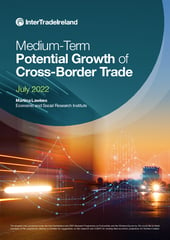Published: July 2022
Executive Summary
This report looks forward over the medium term to provide plausible estimates of potential trade growth between Ireland and Northern Ireland. The motivation for this study comes from the well-established relationship between trade and overall economic growth and, hence, the usefulness to business and policy-makers of having plausible growth paths to guide targets and benchmark the contribution of supports to trading activity.
The path for overall growth potential is based on macroeconomic projections for both economies and an analysis of the key drivers of trade flows based on international evidence. The analysis is undertaken at a detailed sectoral level in order to identify areas with particularly strong growth potential.
To take into account the substantial increase in trade that occurred in some goods sectors in 2021, we use a number of scenarios for our projections. These include taking the 2021 level as the starting point for the projections, adjusting the starting point down slightly (to allow for potential temporary changes such as COVID-19 impacting supply chains) and a convergence scenario (whereby the specific sectors identified as trading below the expected level generated by the gravity model predictions “catch-up” to the level predicted by the model).
The key findings of the report are:
Growth rates for goods trade are expected to be reasonably similar in both directions of trade, averaging around 2.5% a year. In the convergence scenario, the average growth rates increase to between 3.2% and 4.2%.
In level terms goods going from Ireland to Northern Ireland in 2020 were approximately 2.3 billion euros. By 2030, this trade is projected to reach a value of between €3.79 billion in the lowest scenario and €4.55 billion in thehighest scenario (with no inflation taken into account). From Northern Ireland to Ireland, trade in 2020 starts at €2.42 billion and could increase to between €4.78 billion and €6.07 billion depending on the scenario.
These growth rates are not even across all sectors within goods. The overall patterns from 2021 to 2030 show a shift in the composition of goods trade away from food and crude materials towards chemicals and machinery. The key areas for growth appear similar in both trade directions suggesting substantial potential for development of supply linkages across the island.
Trade in services is projected to grow at a substantially more rapid pace than trade in goods. Although currently services trade is considerably lower than goods trade, these results would see services converging in level terms towards an equivalent value to goods trade over the course of the decade to 2030.
The annual average growth rate for services trade comes in at around 10% for trade from Ireland to Northern Ireland and 9.1% for services from Northern Ireland to Ireland. Cumulatively, this would result in services trade in both directions being approximately double its 2021 level by 2030.
Although detailed data on the components of cross-border services trade is limited, comparable international evidence suggests that the growth in services trade is likely to be particularly strong in financial services and business services.
The projections in the report are based on estimates of a number of key drivers benchmarked to international evidence. These may prove conservative as policy initiatives supporting innovation and skills development could both directly impact the trade patterns of targeted sectors and also indirectly support trade growth on aggregate through a positive reinforcement cycle with GDP, one of the key drivers of the projections in this report.
You can download a copy of the full Medium-Term Potential Growth of Cross-Border Trade Report .
Select this link to give us a few details about yourself and we will send you the report instantly.

